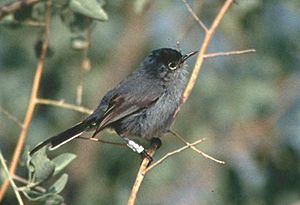California gnatcatcher facts for kids
Quick facts for kids California gnatcatcher |
|
|---|---|
 |
|
| Conservation status | |
| Scientific classification | |
| Genus: |
Polioptila
|
| Species: |
californica
|
| Subspecies | |
|
|
 |
|
The California gnatcatcher (Polioptila californica) is a small bird, about 10.8 cm (4.3 in) long. It loves to live in thick, bushy areas along the coast. This bird mostly eats insects. It's often seen alone, but in winter, it might join groups of other birds.
What it Looks Like
The male California gnatcatcher is mostly a dusty gray color. It has a black cap on its head and a thin black beak. Its long, thin tail is also black, with small white tips and edges underneath. In winter, the male's colors fade, and it looks more like the female. The female is similar to the male, but her cap is blue-gray instead of black.
These birds live in coastal Southern California and down through Baja California. They don't migrate, meaning they stay in the same area all year. You might not always see them because they dart quickly into the bushes. But you can often hear their call, which sounds like a kitten's meow: a rising and falling zeeeeer, zeeeeer.
What it Eats
The California gnatcatcher's diet is simple: it eats small insects and spiders.
Where it Lives
In most of its home range, especially in the Baja California peninsula, the California gnatcatcher lives in dry places like deserts and scrublands. However, in Baja California and California, it lives only in a special kind of habitat called coastal sage scrub.
This coastal sage scrub habitat is very important to the gnatcatcher. Sadly, a lot of this land has been lost in the U.S., with estimates saying 70 to 90 percent is gone. Because of this, the United States Fish and Wildlife Service listed the California gnatcatcher as a Threatened species in 1993. This means it's likely to become endangered if its habitat keeps disappearing. The bird's small groups are easily separated and reduced in size when their habitat is developed for homes and businesses.
Even though some of its habitat is now protected in places like state parks, the gnatcatcher's populations are still very spread out. People are working hard to save more open land in southern California. These efforts help make sure this special bird doesn't disappear from its home.
Family Life
California gnatcatchers usually form pairs that stay together. They build cone-shaped nests and care for their young. A female gnatcatcher typically lays 3 to 5 eggs. Sometimes, another bird called a brown-headed cowbird will lay its eggs in the gnatcatcher's nest, making the gnatcatcher raise the cowbird chicks instead of its own.


